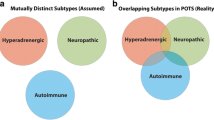Summary
-
1.
Five patients with severe intermittent limb causalgia, who were able to imagine strong hyper- and hypoalgesia in the causalgic limb during relaxation under hypnosis, were investigated.
-
2.
The arterial blood pressure, the heart rate, and the blood flows (venous occlusion plethysmography) in both forearms and hands, or in both calves and feet were recorded during a fixed pattern of 6 successive periods: 1. resting (alert), 2. muscular and mental relaxation, 3. hypnotic imagination of intense hyperalgesia in the causalgic limb, 4. hypnotic imagination of intense hypoalgesia in the causalgic limb, 5. control relaxation, 6. control resting.
-
3.
During the initial, prehypnotic relaxation period a slight decrease of all blood flow values, especially those in hands or feet, occurred. During the second, post-hypnotic control relaxation period, the blood flows in both hands or feet showed a marked increase but the other values returned to normal. Hands or feet blood flows also returned to normal during the following control resting period.
-
4.
The most definite, and reproduceable, circulatory changes were regularly seen during hypnotic imagination of intense hyperalgesia in a causalgic limb. The arterial blood pressure, the heart rate, and the blood flows in both forearms or calves increased while the blood flows in hands or feet decreased. These blood flow changes were more pronounced in forearm or calf of the causalgic extremity than in the corresponding part of the non-causalgic extremity.
-
5.
It is concluded that hypnotic imagination of intense hyperalgesia in a causalgic extremity was accompanied by definite cardiovascular changes, especially in the limbs. The blood flow changes in forearms and calves were probably mainly in muscle while those in hands and feet were probably mainly in skin; vasomotor reactions seemed to be partly responsible. The results agree with, and extend, previous findings.
Zusammenfassung
-
1.
Fünf Patienten mit schwerer intermittierender Kausalgie in einer Extremität, in welcher hypnotisch starke Hyper- wie Hypoalgesie induziert werden konnten, wurden untersucht.
-
2.
Arterieller Blutdruck, Herzfrequenz und Durchblutung (venöse Okklusionsplethysmographie) in beiden Unterarmen und Händen oder Waden und Füßen wurden gemessen. Die Untersuchungen verliefen nach einem festen Schema, bestehend aus sechs aufeinanderfolgenden Perioden: 1. Kontrolle im Wachzustand, 2. prähypnotische muskuläre und psychische Entspannung, 3. hypnotische Induktion intensiver Hyperalgesie in der kausalgischen Extremität, 4. hypnotische Induktion intensiver Hypoalgesie in der kausalgischen Extremität, 5. posthypnotische Kontrolle bei Entspannung, 6. posthypnotische Kontrolle im Wachzustand.
-
3.
Während der initialen, prähypnotischen Entspannungsperiode fielen sämtliche Durchblutungswerte leicht ab, besonders in Händen oder Füßen. In der zweiten, posthypnotischen Entspannungsperiode stieg die Durchblutung in Händen oder Füßen markant an, während die übrigen Werte zu den Ausgangsbereichen zurückkehrten. Hand- oder Fußdurchblutung erreichten die Ausgangsbereiche erst wieder während des folgenden Wachzustandes.
-
4.
Die stärksten und reproduzierbaren Kreislaufänderungen fanden sich regelmäßig bei hypnotischer Induktion von intensiver Hyperalgesie in der kausalgischen Extremität. Arterieller Blutdruck, Herzfrequenz und Durchblutung in beiden Unterarmen oder Waden stiegen markant an, während die Durchblutung in beiden Händen oder Füßen abfiel. In Unterarm oder Wade waren diese Durchblutungsänderungen stärker in der kausalgischen als kontralateral in der nichtkausalgischen Extremität.
-
5.
Hypnotische Induktion von intensiver Hyperalgesie in einer kausalgischen Extremität führte zu sicheren Kreislaufänderungen, besonders solchen der Extremitätendurchblutung. Diese Durchblutungsänderungen erfolgten in Unterarm und Wade wahrscheinlich vornehmlich in der Skeletmuskulatur, in Hand und Fuß wahrscheinlich vornehmlich in der Haut; vasomotorische Reaktionen schienen mitbeteiligt. Die Ergebnisse erweitern frühere, zum Teil ähnliche Befunde.
Similar content being viewed by others
References
Barber, T. X.: Physiological effects of hypnosis. Psychol. Bull.58, 390 (1961).
Berg, W., L. Delius u.E. Schildge: Über die Auswirkungen psychischer Erlebnisse während der Hypnose auf den venösen Rückfluß im Kreislauf. Z. Kreisl.-Forsch.37, 691 (1948).
Bigelow, N., G. H. Cameron, andS. Koroljow: Two cases of deep hypnotic sleep investigated by the strain-gauge plethysmograph. Int. J. clin. exp. Hypnos.4, 160 (1956).
Black, S., O. G. Edholm, R. H. Fox, andD. J. Kidd: The effect of suggestion under hypnosis on the peripheral circulation in man. Clin. Sci.25, 223 (1963).
Chertok, L.: Hypnosis. 176 pp. Oxford: Pergamon Press 1966.
Davis, L. W., andR. W. Husband: A study of hypnotic suggestibility in relation to personality traits. J. abnorm. soc. Psychol.26, 175 (1931).
Deckert, G. H., andL. J. West: Hypnosis and experimental psychopathology. Amer. J. clin. Hypn.5, 256 (1963).
Delius, L., H. Freund, W. Gehle, I. v.Hattingberg, M. Schlepper u.E. Witzleb: Über peripher-reflektorisch und zentralnervös ausgelöste vasomotorische Reaktionen. Klin. Wschr.40, 1187 (1962).
Doupe, J., W. R. Miller, andW. K. Keller: Vasomotor reactions in the hypnotic state. J. Neurol. Psychiat.2, 97 (1939).
Erikson, U.: Circulation in traumatic amputation stumps. An angiographical and physiological investigation. Acta radiol. (Stockh.) Suppl.238, 122 pp. (1965).
Estabrooks, G. H. (Ed.): Hypnosis — current problems. 285 pp. New York-Evanston: Harper & Row 1962.
Finer, B.: The plantar response as an index of hypnotic analgesia. 1st. Congr. int. Méd. Psychosom. Matern., pp. 163–166. Paris: Gauthier-Villars 1965.
—: Experience with hypnosis in clinical anaesthesiology. Opusc. med. (Stockh.)11, 127 (1966).
-, and K.Graf: Mechanisms of circulatory changes accompanying hypnotic imagination of hyperalgesia and hypoalgesia in causalgic limbs. (In preparation.)
Folkow, B.: Transmural pressure and vascular tone — some aspects of an old controversy. Arch. int. Pharmacodyn.139, 455 (1962).
—, andB. Löfving: The distensibility of the systemic resistance blood vessels. Acta physiol. scand.38, 37 (1956).
Golenhofen, K.: Physiologie des menschlichen Muskelkreislaufes. Marburger Sitzungsberichte84, 167 (1962).
—, u.G. Hildebrandt: Psychische Einflüsse auf die Muskeldurchblutung. Pflügers Arch. ges. Physiol.263, 637 (1957).
Graf, K.: Auswertung und Meßfehler okklusionsplethysmografischer Durchblutungsregistrierungen. Acta physiol. scand.60, 120 (1964).
—, andG. Ström: Circulatory and psychophysiological reactions to adrenaline and noradrenaline in patients with vasoregulatory asthenia. Z. ges. exp. Med.140, 91 (1966).
Hagbarth, K. E., andB. Finer: The plasticity of human withdrawal reflexes to noxious stimuli in lower limbs. Progr. Brain Res.1, 65 (1963).
Harano, K., K. Ogawa, andG. Naruse: A study of plethysmography and skin temperature during active concentration and autogenic exercise. In: Autogenes Training — Correlationes Psychosomaticae. (Ed.:W. Luthe), p. 55. Stuttgart: Thieme 1965.
Ikemi, Y., S. Nakagawa, M. Kimura, H. Dobeta, Y. Ono, andM. Sugita: Bloodflow change by autogenic training — including observations in a case of gastric fistula. In: Autogenes Training — Correlationes Psychosomaticae. (Ed.:W. Luthe), p. 64. Stuttgart: Thieme 1965.
Jacobson, E.: Progressive relaxation. Chicago: Univ. Chicago Press 1938.
Kline, M. V. (Ed.): Clinical correlations of experimental hypnosis. 524 pp. Springfield (Ill.): Thomas 1963.
Konzett, H.: Der Einfluß von emotionellen Belastungen auf die Durchblutung der Extremitäten des Menschen. In: Funktionsabläufe unter emotionellen Belastungen (Ed.:K. Fellinger), pp. 64–81. Basel-New York: Karger 1964.
Luthe, W.: The clinical significance of various forms of autogenic abreaction. Proc. 3rd. World Congr. Psychiat., Montreal. III. pp. 485–488 (1961).
—: Autogenic training: method, research and application in medicine. Amer. J. Psychother.17, 174 (1963).
Marcuse, F. L.: Hypnosis, fact and fiction. A discussion and analysis of its theory and technique. 244 pp. Harmondsworth/Middlesex: Penguin Books Ltd. 1959.
Mason, A. A.: Hypnotism for medical and dental practitioneers, pp. 223. London: Secker & Warburg 1960.
May, J. R., andW. E. Edmonston: Hypnosis and a plethysmographic measure of two types of situational anxiety. Amer. J. clin. Hypn.9, 109 (1966).
Müller-Hegemann, D. (Ed.): Aktuelle Hypnose-Probleme. Psychiat. Neurol. med. Psychol. (Lpz.) Suppl.3, 83 pp. (1964).
Platonov, K.: The word as a physiological and therapeutic factor. The theory and practice of psychotherapy according to I. P.Pavlov. 452 pp. Moscow: Foreign Lang. Publ. House 1959.
Polzien, P.: Die Änderung der Temperaturregulation bei der Gesamtumschaltung durch das autogene Training. Ein physikalischer Nachweis des hypnotischen Zustandes. Z. ges. exp. Med.125, 469 (1955).
- Über die Physiologie des hypnotischen Zustands als eine exakte Grundlage für die Neurosenlehre. Bibl. Psychiat. Neurol.107, 74 pp. (1959).
Reading, H. E.: The radial pulse as a guide in hypnosis. Amer. J. clin. Hypn.6, 275 (1964).
Rensen, D. van: Physiologische Befunde bei hypnotischen Bewußtseinszuständen. M.D.-Thesis. 52 pp. University of Tübingen/W. Germany: 1967.
Rieckert, H.: Plethysmographische Untersuchungen bei Konzentrations- und Meditationsübungen. Ärztl. Forsch.21, 61 (1967).
Sapir, M., andF. Reverchon: Modifications objectives — circulatoires et digestives — au cours du Training Autogène. In: Autogenes Training. Correlationes Psychosomaticae (Ed.:W. Luthe), p. 59. Stuttgart: Thieme 1965.
Schultz, J. H., andW. Luthe: Autogenic training. A psychophysiologic approach in psychotherapy. 289 pp. New York-London: Grune & Stratton 1959.
Shepherd, J. T.: Physiology of the circulation in human limbs in health and disease. 415 pp. Philadelphia-London: Saunders 1963.
Stokvis, B., andD. Langen: Lehrbuch der Hypnose. 2. Aufl., 104 S. Basel-New York: Karger 1965.
Strosberg, I. M., andI. I. Vics: Physiologic changes in the eye during hypnosis. Amer. J. clin. Hypn.4, 264 (1962).
Talbert, G. A., F. L. Ready, andF. W. Kuhlman: Plethysmographic and pneumographic observations made in hypnosis. Amer. J. Physiol.68, 113 (1924).
Uber, T.: Wärmeleitmessung bei autogenem Training und gestufter Aktivhypnose. M.D.-Thesis. 24 pp. University of Tübingen/W. Germany: 1966.
Vanderhoof, E., andJ. Clancy: Effect of emotion on blood flow. J. appl. Physiol.17, 67 (1962).
Walden, E. C.: A plethysmographic study of the vascular conditions during hypnotic sleep. Amer. J. Physiol.4, 124 (1900).
West, L. J., K. C. Niell, andJ. D. Hardy: Effects of hypnotic suggestion on pain perception and galvanic skin response. Arch. Neurol. Psychiat. (Chic.)68, 549 (1952).
Whelan, R. F.: Control of the peripheral circulation in man. (Amer. Lectures of Living Chemistry). 316 pp. Springfield (Ill): Thomas 1967.
Woodward, J. W.: Hypnosis and the neuro-endocrine response. In: Hypnosis in anesthesiology (Ed.:J. Lassner), p. 25. Berlin-Göttingen-Heidelberg: Springer 1964.
Young, P. C.: Experimental hypnotism: a review. Psychol. Bull.38, 92 (1941).
Zikmund, V.: Plethysmographische Veränderungen im hypnotischen und im natürlichen Schlaf. Psychiat. Neurol. med. Psychol. (Lpz.) Suppl.3, 26 (1964).
Author information
Authors and Affiliations
Additional information
Thanks are due toUno Erikson, M.D., for help with the angiography. The investigations were supported by grants from the Swedish Medical Research Council and the Swedish National Association against Heart and Chest Diseases.
Rights and permissions
About this article
Cite this article
Finer, B., Graf, K. Circulatory changes accompanying hypnotic imagination of hyperalgesia and hypoalgesia in causalgic limbs. Z. Gesamte Exp. Med. 146, 97–114 (1968). https://doi.org/10.1007/BF02043776
Received:
Issue Date:
DOI: https://doi.org/10.1007/BF02043776




